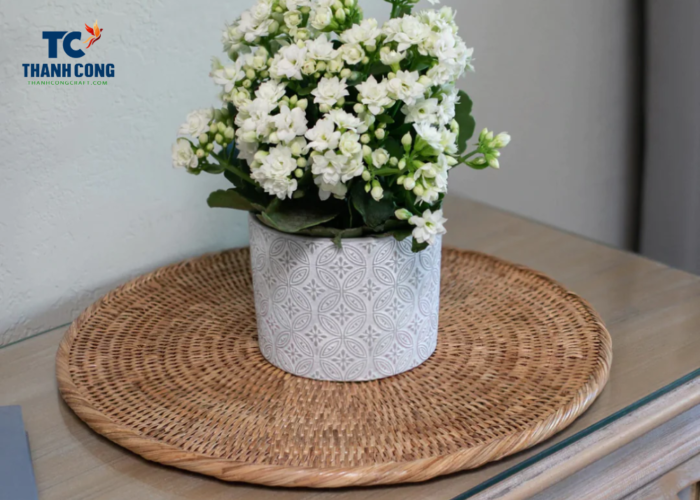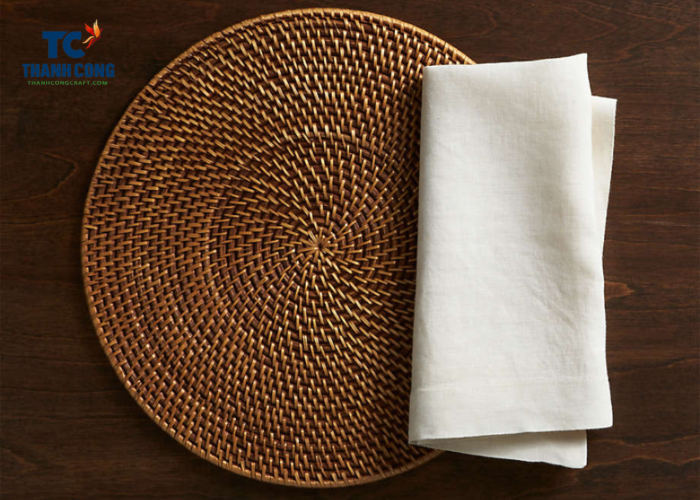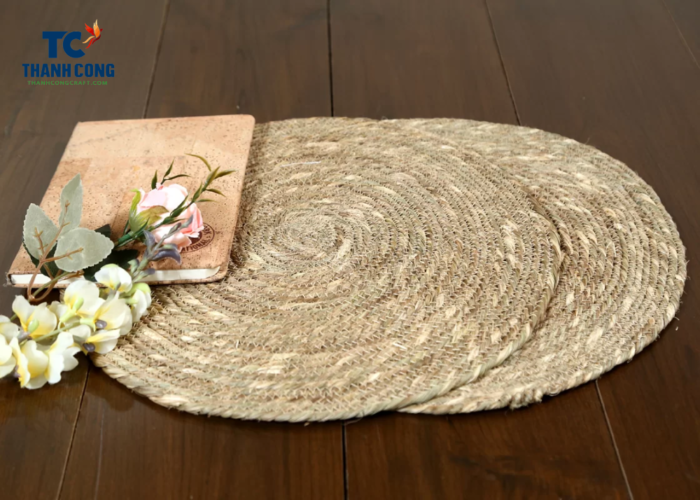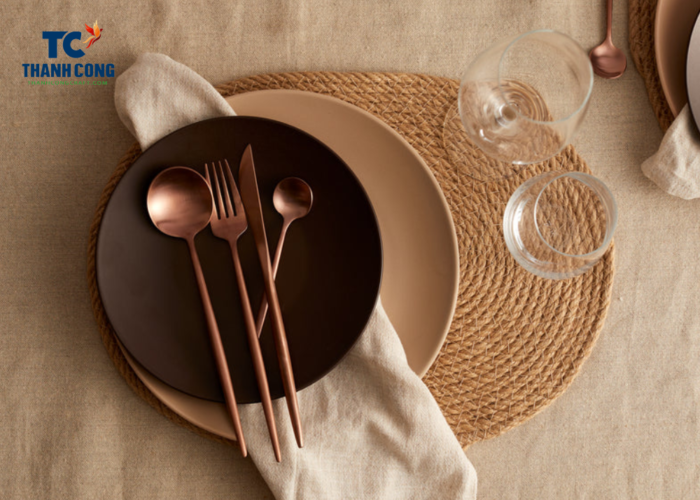Wicker placemats (from natural materials such as rattan, bamboo, jute, woven, etc) renowned for their popularity and exquisite beauty, stand as a favored choice for enhancing table aesthetics. Yet, maintaining their cleanliness and durability requires a proper understanding of the correct cleaning methods. So, can you wash woven placemats? In this article, we will guide you on how to clean wicker placemats effectively and safely.
Contents [hide]
1. How to clean rattan and bamboo placemats?
Rap and bamboo are two types of natural materials that are commonly used to make table mats. However, to preserve them well, you need to know how to clean them properly. Here are some simple steps to help you clean rap and bamboo table mats effectively.
Step 1
Prepare the cleaning solution. You can use warm water diluted with mild soap or dishwashing liquid. If the placemat has a bad smell, you can add a little vinegar to the solution. This cleaning solution helps effectively remove dirt and accumulated grease on the placemat without causing harm to the rattan material.
Warm water softens stubborn residues, while mild soap or dishwashing liquid enhances the cleaning power. This combination ensures a safe and efficient cleaning process.

Step 2
Wet a soft cloth or cotton ball with the cleaning solution. Gently squeeze to avoid excessive water dripping. The soft cloth or cotton ball also helps ensure detailed access to and cleaning of small crevices and corners, enhancing the cleaning efficiency and leaving the placemat looking shinier.
Step 3
Gently wipe the placemat with the wet cloth or cotton ball. You should wipe in the direction of the rattan or bamboo fibers to avoid damaging them. Gentle wiping aids in removing dirt and grease without diminishing the natural beauty of the rattan.
If faced with stubborn residues, applying a slightly firmer pressure is acceptable, but be cautious to avoid vigorous wiping, as it may harm the surface of the placemat.
Step 4
After completing the cleaning process, drying the placemat is crucial to ensure no residual moisture remains. Use a dry cloth or clean paper towel to gently dry each part of the placemat. Note that careful drying is essential to prevent leaving any water marks or other stains on the surface of the placemat.
If moisture is left behind, it may cause clouding or alter the color of the rattan, diminishing the natural beauty of the product. Thorough and careful drying also helps maintain the placemat’s shine, making it ready for use in your dining space.

Step 5
After drying with a cloth or paper towel, the next step is to let the placemat air dry naturally or hang it up to facilitate an efficient drying process. This helps avoid any remaining water and allows air to circulate through the placemat, ensuring it dries completely.
Note that drying the placemat in a cool place and avoiding direct sunlight or high heat sources is crucial to protect it from the adverse effects of weather conditions or environmental factors.
By following these steps, you can keep your rap and bamboo table mats clean and beautiful. You can also extend their lifespan and create a friendly and natural dining space.
2. How to clean jute and raffia placemats?
Jute and raffia placemats add a touch of natural elegance to any dining setting, but keeping them clean is essential to preserve their beauty and durability.
In this guide, we’ll walk you through the steps on how to effectively clean jute and raffia placemats, ensuring they remain a stylish and functional addition to your table decor.
Step 1
Begin by preparing a cleaning solution. Mix warm water with a small amount of mild soap or dishwashing liquid. This solution is gentle enough to clean your placemats without causing damage to the natural fibers of jute and raffia. Ensure that the soap is thoroughly dissolved in the water.
Step 2
Before applying the cleaning solution to the entire placemat, it’s advisable to test it in a small, inconspicuous area. This helps ensure that the solution doesn’t cause discoloration or damage to the fibers. If the test area shows no adverse effects, proceed to the next step.

Step 3
Dampen a soft cloth or sponge with the prepared cleaning solution. Avoid soaking the placemat excessively, as over-wetting can lead to damage. The goal is to have a damp cloth that is sufficient for cleaning without saturating the natural fibers.
Step 4
With the damp cloth or sponge, gently wipe the surface of the jute or raffia placemat. Wipe in the direction of the fibers to prevent damage. Pay special attention to any stained or soiled areas, and apply a bit more pressure if needed. Remember to be gentle to avoid fraying or weakening the fibers.
Step 5
After cleaning, use a dry, clean cloth or paper towel to blot any excess moisture from the placemat. Press the cloth gently against the fibers to absorb residual water. This step is crucial to prevent mold or mildew growth and maintain the integrity of the natural materials.
Step 6
Allow the jute or raffia placemat to air dry completely. Lay it flat on a clean, dry surface away from direct sunlight or heat sources. Proper air circulation is essential for a thorough drying process and preventing any potential damage from excessive moisture.
3. How do you preserve wicker placemat?
Rattan table mats are beautiful and convenient decorations for the dining table. However, to keep the rattan table mats beautiful and durable, you need to pay attention to how to preserve them. Here are some suggestions for you:
- Avoid exposing rattan table mats to direct sunlight, high temperature or excessive humidity. These factors can cause the rattan to fade, warp or mold.
- After use, you should wipe the rattan table mats with a damp cloth or a soft rag. Avoid using strong detergents or rubbing too hard, as this can damage the rattan fibers.

- When not in use, you should store the rattan table mats in plastic bags or boxes that have moisture and insect resistance. You should also fold the rattan table mats according to their original shape, avoiding breaking or deforming them.
- When the rattan table mats are damp or moldy, you can dry them under mild sunlight for about 15-20 minutes, then wipe them with a solution of vinegar and warm water. To remove the odor, you can sprinkle some salt on the surface of the table mats and leave them overnight, then wipe them again in the morning.
Rattan table mats are environmentally friendly products and bring a cozy feeling to the living space. You just need to follow the simple preservation methods above, you will have beautiful and long-lasting rattan table mats.
4. FAQs
4.1 Are rattan placemats easy to clean?
Cleaning rattan placemats is a straightforward and manageable task. These placemats are generally easy to clean, requiring a few simple steps to maintain their beauty and functionality. To begin, prepare a gentle cleaning solution by mixing warm water with mild soap or dishwashing liquid. If there is an unpleasant odor, adding a small amount of vinegar to the solution can be effective.
Wet a soft cloth or cotton ball with the cleaning solution, ensuring it’s damp but not overly wet. Gently wipe the placemat in the direction of the rattan fibers to prevent damage. After cleaning, use a dry cloth or paper towel to carefully blot away excess moisture, avoiding the formation of water marks.
For the drying process, it’s advisable to let the placemat air dry on a flat surface or hang it up. However, ensure that this is done in a cool place away from direct sunlight or heat sources to prevent any potential harm. This careful approach to cleaning ensures that rattan placemats remain not only clean but also well-preserved, maintaining their natural charm for an extended period.
4.2 How to clean wicker placemats in washing machine?
Cleaning wicker placemats in a washing machine is not recommended due to the delicate nature of wicker materials. Wicker, often crafted from natural elements like rattan, bamboo, or reed, can easily lose its strength and shape when subjected to the mechanical action and moisture involved in machine washing. Therefore, it is advisable to adopt a more gentle hand-cleaning approach.
To clean wicker placemats effectively, start by preparing a mild cleaning solution using warm water and a small amount of soap or dishwashing liquid. If there are any unpleasant odors, a touch of vinegar can be added to the mix. Dampen a soft cloth or sponge with this solution, ensuring it’s not overly wet, and gently wipe the placemat in the direction of the natural fibers.
After cleaning, use a dry cloth or paper towel to blot away excess moisture carefully. To complete the process, allow the wicker placemat to air dry completely on a flat surface or hang it up in a cool, shaded area away from direct sunlight. This manual cleaning method ensures the preservation of the woven pattern and structural integrity of the wicker, extending the lifespan and maintaining the aesthetic appeal of your placemats.
In conclusion, knowing how to clean wicker placemats is essential for maintaining their longevity and aesthetic appeal. These charming table accents, often crafted from natural materials like rattan, bamboo, or reed, require a gentle cleaning approach to preserve their structural integrity. Avoiding machine washing is crucial, as the delicate fibers of wicker can be easily damaged.
If you have any further questions, don’t hesitate to send thanhcongcraft an email us at info@thanhcongcraft.com or message us at WhatsApp: +84967485411. Hope to serve you soon! Best regard!


